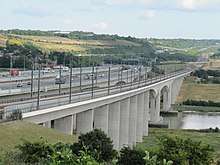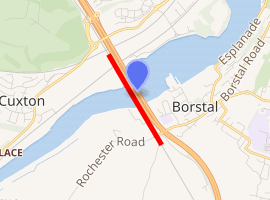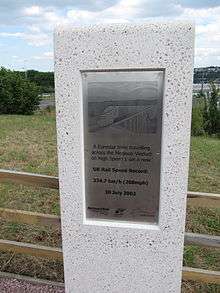Medway Viaducts
The Medway Viaducts are three bridges or viaducts that cross the River Medway between Cuxton and Borstal in north Kent, England. The two road bridges carry the M2 motorway carriageways. The other viaduct carries the High Speed 1 railway line.
Medway Viaduct | |
|---|---|
 | |
| Coordinates | 51°22′33″N 0°28′32″E |
| Carries | Original:4 lanes of M2 plus hard shoulder & Bridleway New: 4 lanes of M2 plus hard shoulder Rail: 2 tracks of High Speed 1 |
| Crosses | River Medway |
| Locale | Cuxton, England |
| Characteristics | |
| Design | Cantilever |
| Total length | Original: 997.3 metres (3,272 ft) New: Rail: 1,300 metres (4,265 ft) |
| Width | Original: 34.44 metres (113 ft) New: Rail: |
| Longest span | Original: 152.4 metres (500 ft) New: Rail:152.4 metres (500 ft) |
| Clearance below | Original: 35.5 metres (116 ft) at maximum New: Rail: |
| History | |
| Opened | Original: 29 May 1963 New: 2003 Rail: September 2003 |

| |


Original motorway viaduct
Opened on 29 May 1963,[1] by Ernest Marples, Minister of Transport, the Medway bridge formed a key piece of the M2 motorway. It originally had a six-lane (two London-bound, two coast-bound, two hard shoulder) formation. In addition, a footpath either side that doubled as a small service road for maintenance and pedestrians. These footpaths are part of the North Downs Way, offering panoramic views of the Medway Valley and beyond. During the M2 widening, the original bridge was refurbished and strengthened. The central span, which was made from concrete beams, was replaced with steel girders. The concrete beams were lowered down on to a river barge underneath. As part of the M2 widening, the original bridge had street lighting fitted to it for the first time.
Second motorway viaduct
Completed in 2003, as part of the M2 widening project, the second motorway bridge is the newest of the three that cross the River Medway at this point. The bridge was built south of the original bridge. The formation of the M2 motorway crossing was changed. The original bridge would be changed to three coast-bound lanes, a hard-shoulder and both footpaths were reduced in size. The south facing footpath was closed, leaving only one path for pedestrians. The newer of the two bridges had the same formation, but changed to London-bound lanes.
In 2003, the bridge won the Concrete Society’s Civil Engineering Category[2] award for, "outstanding merit in the use of concrete". It was presented to Doka UK Formwork Technologies. A plaque can be seen on one of the upright support legs, on the Strood side.
Railway viaduct

The western bridge carries High Speed 1 (HS1), the high-speed rail link that connects London with the Channel Tunnel.
The rail viaduct is 1.3 km (0.81 mi) long. The viaduct is a multi-span structure, with typical approach spans of 40.5 m (133 ft), spanning the River Medway, Wouldham Road and Burham Roads in Borstal. with a central navigation span of 152 m (499 ft). The viaduct substructure is of reinforced concrete pier columns supported on bored piles. A feature of the columns is that they are in a "V" shape to provide greater lateral support and stability in the event of two high-speed trains using their emergency brakes.
The bridge deck was pushed out from the abutments on the east and west banks of the river during construction using hydraulic ram pistons.
On 30 July 2003, a specially formed Eurostar train crossed the viaduct and in to the Nashenden Valley at 208 mph (335 km/h) which was a new UK rail speed record.[3] To celebrate the tenth anniversary of the UK rail speed record, a plaque was placed overlooking the railway viaduct.
On 29 May 2013 the M2 celebrated its 50th anniversary.[4]
All three bridges pass over the Medway Valley Line (to Paddock Wood).
References
- "Anniversary". Highways Agency. 29 May 2013. Retrieved 13 August 2013.
- "Award". Flint Neill. Retrieved 13 August 2013.
- "Speed record". BBC News. 30 July 2013. Retrieved 15 August 2013.
- "Anniversary". Highways Agency. 29 May 2013. Retrieved 13 August 2013.
External links
| Wikimedia Commons has media related to Medway Viaducts. |